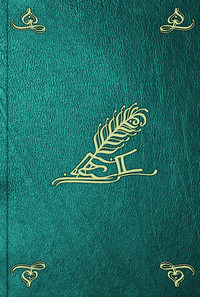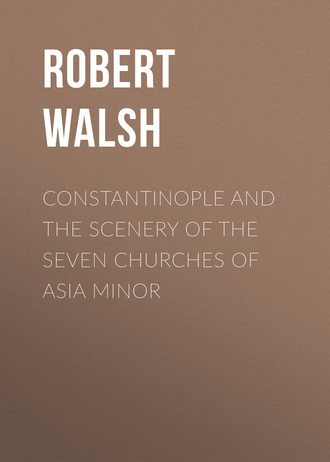 полная версия
полная версияConstantinople and the Scenery of the Seven Churches of Asia Minor
The present population is estimated at 150,000: the greater and more opulent part are Turks; the rest Albanian Greeks, and Jews. Many of them were lately engaged extensively in commerce, and the town contains a spacious bazaar, well supplied with every species of merchandise; but its prosperity has greatly declined: the ruthless hand of Ali Pasha fell on it, in common with all its neighbouring towns; its inhabitants were massacred, its merchants plundered and scattered, and its prosperity, with its commerce, greatly reduced.
Our illustration presents the castle or fortress of the town impending over its beautiful plain. This fortress is one of the most extensive and important in Albania. It contains the seraglio of the pasha, a mosque, and accommodation for a garrison of 5000 men. To secure it against the effects of famine, the rock is hollowed into subterraneous excavations, which form granaries always filled with corn; and in order to be independent of either wind, water, or other uncertain power, the mill by which it is ground is moved by a machinery of clock-work, invented by an ingenious native, which daily yields an abundant supply of flour. The necessary element of water is conveyed from the neighbouring hills by a lofty aqueduct. The works are defended by eighty pieces of English and French ordnance; so that it may be considered one of the most noble and secure mountain-fortresses in Europe.
TOWN AND CASTLE OF PARAMYTHIA, IN ALBANIA.
TURKEY IN EUROPE
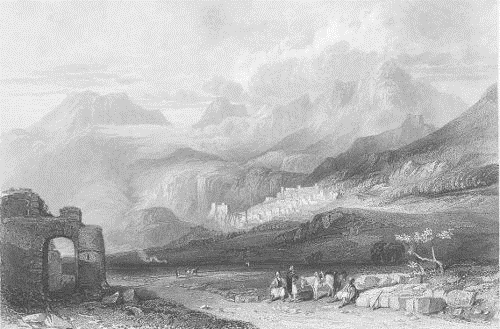
W. L. Leitch. W. Floyd.
More to the south than Joannina, and approaching the Adriatic, are the town and castle of Paramythia. Unlike the former, there are here discovered certain indications of its site having been that of some ancient Greek or Roman city: beautiful specimens of ancient art are daily disinterred, and arches of ponderous and double masonry indicate that its former inhabitants were in a far higher grade of social intelligence than its present possessors. Yet of the ancient city which did occupy this spot, the name has perished, while its remains attest its former existence.
Paramythia, like Argyro-Castro stands at the extremity of a fertile plain, suspended on a rock which overhangs it. The houses, like those of the structure of Albanian towns in general, are all built detached from each other. They indicate, however, the miserable state of insecurity in which the inhabitants live. They resemble so many fortresses closed up on the outside from light and air, pierced only with small loop-holes, from whence is thrust the muzzle of a tophek. They are generally shaded by the spreading branches of the Oriental platanus: this magnificent tree attains to such a gigantic size in the East, as to have been the wonder of antiquity; in the trunk of one tree, 22 people were entertained at supper, and the branches of another overshadowed a whole village. At Paramythia they grow to a magnificent size, and the town is partly covered by their leafy canopies. This luxuriance of vegetation is probably caused by the numerous springs which issue from the hills, and water the roots. Every tree seems to have a pure fountain connected with it. The spacious bazaar of the city is peculiarly marked with this character, shadowed over with a vast canopy of branches, and cooled by many rills of delicious water. Towering above the town is the fortress, reposing on a vast rock, in some places one thousand feet above the plain, and having the town spread over an inclined plain on the side of the mountain just under it The calcareous structure of this rock sometimes gives way, detaching large masses, which overwhelm and crush the houses below on which they fall. The castle is surrounded by an extensive battlemented wall, crowned with turrets. Here it is that the ruins of a former town are most conspicuous. The modern walls are raised on still more ponderous remains of ancient foundations; and the gate-ways of arches yet remain here, of evidently very ancient date.
Our illustration represents the fertile plain below, rich in various productions, full of gardens and shrubs, where the song of the nightingale seldom ceases, and is reported to be particularly sweet and plaintive. High above are the ridges of the great chain of Albanian mountains, which the ancients called Acroceraunian, because their summits were always splintered with thunderbolts; of these sublime hills, five distinct and mighty pinnacles can be traced from hence to the Adriatic. Reposing on the inclined plane of the mountain-side, is the city with its fortress, surrounded with lofty forests of plane-trees, and in front is one of those ancient arches, which indicate the early but unrecorded founder of the city.
THE SULTANA IN HER STATE ARRHUBA.
CONSTANTINOPLE
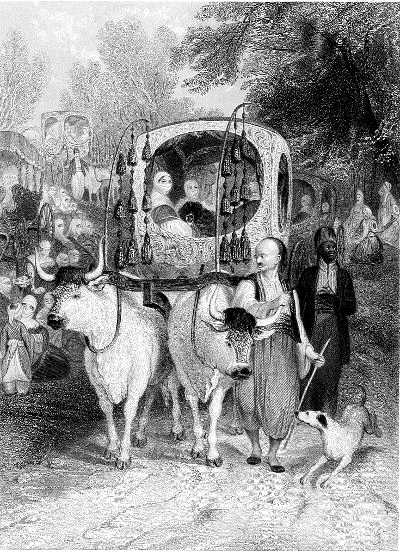
T. Allom. J. Jenkins.
This carriage, peculiarly Turkish, we have already described among the conveyances that thronged the social meetings at the Sweet Waters of Asia. It is here presented as the principal and most conspicuous object of our illustration. The ponderous body of the machine, placed on wheels without springs; the heavy but gilded and gaudy carved-work which covers it; the long-horned oxen which drag it; the singular arches dangling with tassels, to which their tails are generally tied; the dense mass of hair drawn down before, and carefully dyed, like the ladies’ nails, with henna; and the amulets pending over their noses, to guard them from the effects of an evil eye−are here accurately represented. Beside the draught-beasts walks the Greek arrhubagee, leading the docile animals by the horns; and next the carriage is one of the black eunuchs, with his drawn sabre, threatening with instant death the passenger, whose profane eye shall dare to glance at his sacred charge within. It was formerly the indispensable usage, that every arrhuba should be closely covered with silken curtains, so that the inmates were never seen, except when the wind, or the jolting on an uneven road, moved the curtains aside, and revealed for a moment the mysteries of the interior; but recent approximation to European usages has removed this veil, and even open carriages on springs have been seen in the Turkish capital, filled with the secluded females of the harem.
Our illustration represents the Asmé Sultana driving from her palace at Eyoub, through the Valley of the Sweet Waters. Crowds of females line one side of the road; and, with the jealous sense of Turkish propriety, the males, separated from them, line the other. A train of arrhubas follow in the rear, with various ladies of the seraglio.
THE TOMB OF ALI PASHA AND FATIMA, IN THE COURT OF SERAGLIO.
JOANNINA, ALBANIA
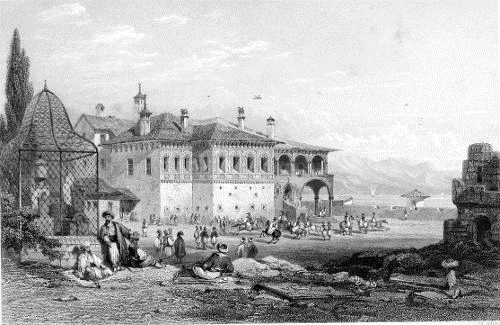
J. L. Leitch. H. Adlard.
The wild mountains of Albania had long slumbered in obscurity, and, though in the immediate vicinity of civilized Europe, and in sight of the coast of Italy, had never been visited by the curious traveller, till Ali Pasha, like some lurid meteor, blazed out in this obscure district, and attracted the notice and admiration of the world by his ability, his courage, his crimes, and his success.
This extraordinary man was born in Tepeleni, a small village of Albania, in the year 1741. His ancestors had been distinguished among the wild chieftains of the district, and his mother, a woman of ferocious energy of character, determined that he should not degenerate. He became expert in all manly exercises, and, at a very early age, distinguished himself among the Kleftes, or robbers, of the country. While absent at a wedding, the inhabitants of Gardaki, a neighbouring and rival village, rushed into Tepeleni, and carried off his mother, and sister Shaïnitza, whom they abused. He vowed he would never rest till he stuffed the cushions of his divan with the hair of all the women of Gardaki. This vow he religiously kept; and after exterminating the inhabitants, and razing the village to the ground, the long tresses, which are the pride and ornament of Albanian women, were shorn from their lifeless remains, and the ferocious sister of Ali exulted while she reposed on the cushions which were stuffed with them.
After a career of crime, in which his cruelty and perfidy were as distinguished as his courage and ability, he at length made himself master, under various pretexts, of all the towns and fortresses in the country, and destroyed, with unrelenting cruelty, every rival whom by force or fraud he could get into his power. He was then confirmed by the Turks in the pashalik of all Albania, and he made Joannina his residence, and the capital of his territory. Here he invited all the distinguished travellers in Europe to visit him; and by their reports, his name soon expanded beyond the obscurity of his native mountains.
After enjoying for half a century this celebrity, the Turks became jealous of his power, and determined to depose him. He resisted all their open efforts, and at length fell a victim to a perfidy equal to his own. A pasha paid him a friendly visit, and, after many professions of good will, rose to take his leave, and made him the usual obeisance. Ali returned it, and before he could recover himself, his visitor stabbed him in the back, and his yatagan passed directly through his heart, and out of his breast. Thus perished, at the age of eighty-one “the old lion,” as the Turks denominated him. His head was cut off, and despatched, with his last wife, Vacilesso, to Constantinople, where it was exposed for three days on a silver dish in the courts of the seraglio. The heads of his four sons and grandson were sent after him; and they are all interred, with suitable monuments, outside the walls of Constantinople, and are the first objects seen by travellers after passing the Selyvria gate. The body was embalmed, and buried with that of his first wife, Fatimah or Ermineh, in a mausoleum he had erected for her on the esplanade of the seraglio at Joannina, where it overlooks the lake, as represented in our illustration.
HALT OF CARAVANIERS AT A SERAÏ.
BULGARIA
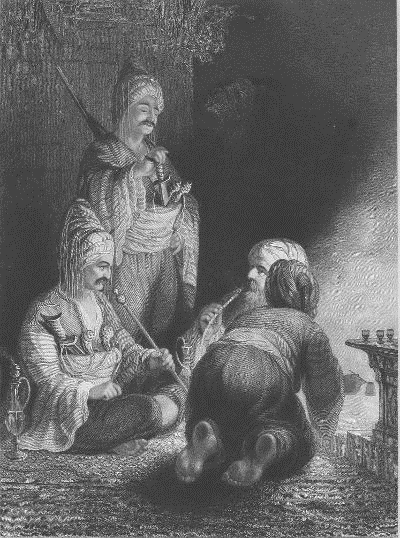
T. Allom. W. H. Mote.
The interior of the Turkish empire is constantly traversed by large bodies of men, who proceed together for protection; and their object is either commerce or devotion. We have already given some account of the first−the second remains to be noticed.
In the sixteenth year of Mahomet’s mission, he ordained that every believer should engage in a pilgrimage, to visit the place of the Caaba, or sacred house of Abraham, which was taken up to heaven at the flood, but its model was left for true believers at Mecca. This ordinance was rigidly observed by his followers. The caliphs set the example; and all Mussulmans hold it an indispensable obligation at this day, when it is possible for them to perform it. Even women are not exempt. If they have no husband or brother, under whose protection they could leave the harem, they are bound to marry, for the express purpose of obtaining one to perform this duty. The only person in the empire exempt is the Sultan; and he only because the pilgrimage would occupy a longer period than he could be legally absent from the capital. He is bound, however, to send a substitute, called Surré Emmini, who always accompanies the caravan of pilgrims, and represents the sovereign. Thus it is that every year above one hundred thousand persons, of all ages and conditions, set out from various points, and traverse Europe, Asia, and Africa, to fulfil this indispensable duty.
The great European caravan assembles at Constantinople in the month of Regib, which, according to the Turkish calendar, falls at every season of the year. They cross the Bosphorus, and unite on the great plain of Scutari, from whence they take their departure. They exhibit a strange display of folly and fanaticism. Among the various groups are seen, at one place jugglers and buffoons exhibiting their light and often indecent mummery; in another, molhas and dervishes exhorting to piety, and tearing their limbs with disgusting lacerations: but the most conspicuous object is the sacred camel; this carries the mahhfil, or seat from which the Prophet preached and dispensed justice in his journeys. The race is religiously kept up in the stables of the seraglio; and some believe the camel of the mahhfil, at this day, is the actual animal on which the Prophet rode, and kept alive by a miracle, to perform this annual journey to his holy city.
Our illustration represents a group of a caravan of the faithful, proceeding from the northern to the southern extremity of the empire, to perform this pilgrimage. The venerable Moslem, who is ambitious of becoming a hadgee, is attended by his guards, distinguished by their fantastic dress, their glittering golden-hafted hanjars, stuck in their shawl-girdles, beside their silver-mounted pistols, and the grave turban replaced by a many-tasselled cap. Their accommodation is the stable of a khan, which their camel equally shares; and their refreshment is coffee, black, thick, and bitter, served by the khangee in small characteristic cups.
THE RUINS OF LAODICEA.
ASIA MINOR
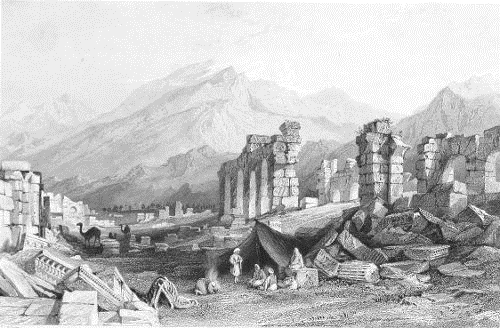
T. Allom. J. Sands.
This last church of the Apocalypse stood in Phrygia, on the river Lycus, near Collosæ. It was first called Diospolis, or the “City of Jupiter,” but changed its name to Laodicea, from the wife of Antiochus, who rebuilt it. It became celebrated for its commerce; the richness of its soil, and the raven fleece of its sheep, were a source of unbounded wealth. It gave birth to many distinguished persons:−Hiero, who named its citizens as heirs to his immense wealth; and Zeno, who, though not the founder of the Stoic sect, was renowned, with his son Polemon, for skill in rhetoric. His name, two thousand years after, was found sculptured on the seats of the theatre.
When Christianity was planted here, it was not received with the eagerness and enthusiasm with which the “new faith” was embraced in other churches. The evangelist, reproaches them with their “lukewarm” zeal, and rebukes their indifference by wishing, they were either “hot or cold.”26 It does not appear that St. Paul ever visited them in his travels; yet he took a great interest in their welfare. He was well acquainted with their character; for he ordered his Epistle to the Colossians to be read to them also, as equally requiring it.27 A letter exists which he is said to have written expressly to them; but it is considered spurious, and not recognized in our canon.
The place was shattered with earthquakes, in common with other cities in the same region; and what was not destroyed by the hand of nature, was more effectually so by the hands of the Turks. In the year 1009 it fell into their power; and from that time it sustained various assaults, during which the inhabitants were massacred, and their Christian bishops driven into captivity, along with their cattle. There is now no modern town built in or near the ancient site; but the extent and magnificence of its ruins, slumbering in dilapidated grandeur, attest what it once was; and various perfect and legible inscriptions still mark the era when it flourished.
Our illustration represents what travellers suppose to have been the senate-house. It consists of many piers, supporting arches of stone; among which lie marble fragments of great beauty, mouldings, cornices, pedestals, and columns, marking by their sculpture and abundance the opulence of the inhabitants, and the advanced state of the arts among them. On a portion of the wall is a legible inscription, creditable to the people. It states that they had “elected Asem to be their magistrate for life, as a reward for his piety and integrity.” Beyond, extending over the plain, are the remains of various edifices−a stadium, amphitheatre, and other evidences of wealth and civilization in this rich country, where all is now solitary and desolate−where a few wandering Turcomans make a temporary abode, and their feldt-tents strongly contrast with what remains of the splendid edifices of its former possessors.
THE CASTLE OF PARGA, ALBANIA.
TURKEY IN EUROPE
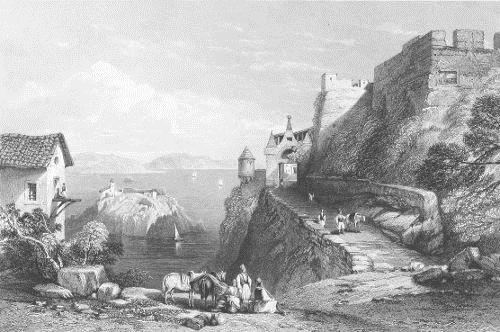
W. L. Leitch. J. Tingle.
Of all the places contained within the circuit of the Ottoman empire, this little town is, perhaps, the most interesting to England; because its fate has compromised that high and before unsullied character for good faith, which had ever distinguished British transactions, and left a stain behind which no length of time can entirely wash away.
This town is of comparatively modern foundation, and was unknown before the fifteenth century. Its erection was attributed to a miracle in the Greek church. The Christian inhabitants had occupied a place in the interior, open to the continued assaults and attacks of the Turkish invaders of the country. While deliberating on searching for a more secure site, a shepherd, following after some stray sheep, discovered, in a cave over the sea, a statue of the Panaya, and brought it with great reverence to a church in the old city. The image, however, would not rest there, but returned to her former abode. It was brought back, but again returned; when the inhabitants, hailing the miraculous omen, followed it, built a church over the cave in which it was found, and commenced a new city round the church. So Parga rose upon its sea-beat rock, impending over the Adriatic, and protected by its impregnable situation from all attacks of the Infidels. The site chosen was particularly beautiful. A conical hill juts out from a deep bay, having secure harbours on each side. From hence the bay sweeps with picturesque curves, embracing with its long arms a magnificent sheet of water; the view terminated behind with the rugged precipice of the Albanian chain, and before by the islands of Paxo and Corfu, floating on a singularly clear and lucid sea. On the summit, over the caves, stands the acropolis of the city; and sloping down the sides, the houses of the inhabitants.
The Venetians, who were then in possession of the Ionian Islands, immediately took this little Christian community, on the opposite coast, under their care, and for many years they greatly prospered. Their town contained four thousand inhabitants, and their territory extended for twenty miles along the shores of the bay. The district had been anciently called Elaiatis, from the excellency of the oil it yielded; and the Parghiotes improved this quality to the utmost. Eighty-one thousand olive-trees clothed the sloping sides of the bay, and the oil of the industrious citizens of Parga was esteemed all over the Levant. The character of the people corresponded with this prosperity−they were esteemed for their piety and integrity. No Parghiote, it is said, was ever found among that numerous class in the country, which were robbers by land and pirates by sea; but, above all, they were distinguished by an ardent love of liberty, and an enthusiastic attachment to their native soil, that nothing could subdue or weaken; and this character they supported in this lawless region for three centuries.
But the tyranny and ambition of Ali Pasha now subdued with resistless violence all the strongholds in that country, and fixed his eye on Parga as a most desirable object. The compassionate citizens had opened their gates to the fugitive Suliotes and other oppressed people, driven from their native towns; and this unpardonable offence had added to the malignant hostility of Ali, and for twenty years he used every stratagem of force or fraud to obtain possession of the place, without effect; till at length the protection afforded to it by England, was the means of gratifying all his evil passions. When the Ionian Islands fell under the dominion of France, the Parghiotes put themselves under its protection, against the power of Ali, and received a French garrison in their town; but when the islands were ceded to the English, the garrison capitulated, and the inhabitants gladly committed themselves to the care of that free and enlightened state, which they had always looked up to with honour and respect, and they were received as an independent ally of the new Ionian republic. The rage of Ali, when he saw his prey thus snatched from him, was ferocious, and vented itself in a bloody sacrifice of other victims. For three years this connection continued, with mutual good-will; and they felt the security of a perfect confidence. The crisis, however, of their fate was at hand.
The Turkish government demanded the town of Parga, as part of their territory, and a secret negotiation was entered into with the English to surrender it. When this transpired, the place was filled with consternation and despair. The people rushed into the streets; they declared, and truly, that deserting them, was only sacrificing them to their bitter persecutors, who had sworn to exterminate them, and they would not survive it, but first destroy their wives and children, and finally themselves and their town. When no entreaty could prevail on them to remain behind the English garrison, they were offered an asylum in the island of Corfu, and a compensation for the property they left behind. To these terms they were compelled to accede, and the Glasgow frigate was sent to protect and convey them. The English found them in their church, disinterring the bodies of their ancestors, and burning their bones, that thus they might not be left to the sacrilegious insults of their enemies. The whole population then descended mournfully down the steep, some bearing the ashes of the dead, some grasping portions of the soil of a place so dear to them, and some the sacred image by whose direction they had chosen it. When arrived on the shore, they all kneeled down with one spontaneous impulse, kissed fervently the sand, and so took a last and sad farewell. Before they went out of the bay, the ferocious Albanians of Ali, who were waiting like famished tigers, rushed into the town. They found nothing that had life, all was still and motionless except the columns of smoke that was still eddying up from the ashes of the dead.
The desponding remains of this interesting people, after continuing for a short time in the Ionian Islands in poverty and distress, soon dispersed; the broken community was absorbed in other populations, and the name forgotten; and the traveller who sails to Corfu, looks up as he passes this lovely bay, and sees the remains of this aërial city, lately the residence of the free, industrious, and native Christian community, now the den of some of the most ferocious and savage hordes of Turks in the Ottoman empire.
CASTLE AND VALLEY OF SULI, THE ANCIENT ACHERON.
ALBANIA
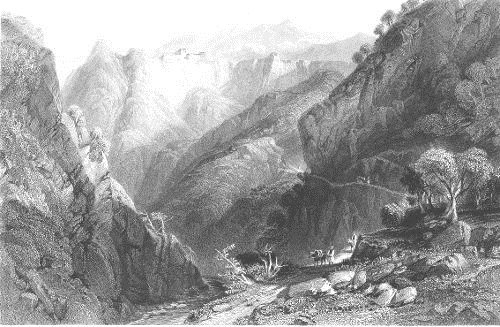
W. L. Leitch. C. Bentley.
Where the dark Acheron, now called the Kalamas, rolls its gloomy tide, among the recesses of chasms so deep and shadowy, that the wild imaginations of the Greek poets called it a river of hell−and the district through which it ran, the entrance to the infernal regions−stood the city of Suli, as distinguished as Parga by the bloody enmity of Ali Pasha.
In this country, for ages unsettled by any regular government, and disturbed by the constant warfare of petty beys and pashas, security of site was the strongest recommendation for erecting a town. A traveller winding his way through the chasms and ravines of these dark mountains, emerges unexpectedly on the summit upon a broad and fair platform. Here, 2000 feet above the bed of the Acheron, the tribe of Suli built their cities, and in this elevated rocky fastness fixed their chief abode, which they called Kako-Suli, from the exceeding difficulty of climbing up to it. On this lofty table-land were four populous towns, and they held sixty-six tributary villages, built on every available spot among the ravines and precipices below. The character of these mountaineers, and their peculiar habits, long distinguished them among their neighbours. Their fierce and unsubdued courage, their endurance of fatigue and privation, their skill in warlike weapons, caused them to be looked up to with great respect. Wherever they appeared, they were recognized by characters which marked them. Their skin was of a dark bronze colour; constantly exposed to sun and wind, and unprovided with the shelter of tents in their expeditions, the surface of the exposed parts attained the colour and consistency of tanned leather, and almost an equal insensibility. Their dress was a long white capote, strongly contrasted with the colour of their skin. They wore on their head a small cap called a fez, resembling an inverted saucer, scarcely covering the top of the crown, from under which a long lock of hair streamed in the wind. Their arms were the tophek or musket without a bayonet, and in their girdle not a straight yatagan, but a crooked sabre. Thus distinguished was




